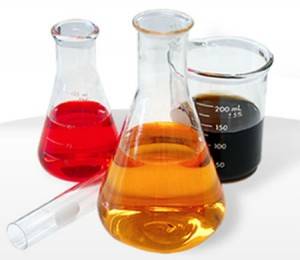A fuel and oil decoloration process is needed to reinstate oil products to marketable condition. Different contaminants have a great impact on the natural colour of oil products. These contaminnants can get into the oil during transportation or storage as well as during operation. In many cases it is the colour that allows you to assess the quality of fuel or oil, but it shouldn’t be taken for granted. The following is a discussion of the basic purification technologies for oil products:
(1) Leaching. This method is considered to be the simplest one and consists of processing oil with an alkali solution. The alkali affects the organic acids in the oil. The remains of the oxidative polymerization (petroleum resins) found in the oil product are the main disadvantage of this method.
(2) Acid-Contact and Acid-Alkaline Purification. The sulfuric acid is used as the main substance that interacts with unwanted contaminants. It can destroy asphalt-resinous and unsaturated compounds. Acid sludge is a by-product. The main advantage of this method is that the acid doesn’t influence cyclic hydrocarbons that are very important for oil products.
When the acid purification and separation of acid sludge are done, a resulted substance should be washed by an alkali water solution to destroy the residuals of the acid sludge. The oil product is washed by water and is dried by steam or hot air at the final stage of purification. A high flow of reagents however, is needed for oil purification. Additionally, acid sludge is a quite toxic and dangerous waste product. The large cluster of acid sludge also has a negative impact on the environment.
(3) Decoloration of Oil by Selective Solvents. The distinctive feature of this method is the possibility to use selective solvents many times during the purification process. Such chemical substances as “furfural” or “phenol” are mostly used to lighten oil.
In the course of selective purification, a special solvent dissolves contaminants and at the same time does not affect, or affects poorly, the “good” components of the oil product.
The solvent is mixed with contaminants and then separated from them during the sedimentation process. A layer of oil, affected by the solvent, is processed by bleaching clay. It is very important to find an optimal proportion between the oil and the solvent. Additionally, the proper temperature is no less important during the process of purification.
Solvent pairs are used to improve the purification process of high viscosity residual oils. One of them selectively dissolves contaminants and the other purifies the oil.
(4) The “Hydrogenezation” purification method has been widely used recently. A certain pressure (up to 2 mPa) and the hydrogen being heated to between 380ºC/716ºF and 400 ºС/752ºF is needed to carry out this process.
Particular attention should be paid to oil quality at low-temperatures. Such processes as deasphaltizing and dewaxing are used to solve this problem. They seek to remove compounds (with high chilling temperature) from the oil products.
(5) Liquid propane is needed to carry out the process of deasphaltizing. It is mixed with clean product in the ratio of 10 to 1 with the pressure from 2 to 4 mPa. The process itself is carried out in a special stand of pipes.
(6) Dewaxing consists of the releasing of paraffins and ceresines from oil by cooling. A solvent is added and the mixture is heated before cooling. The temperature of heating should be at least 15ºC/59ºF to 20ºC/68ºF higher than the ambiant temperature of the oil. The heating is needed for paraffins and ceresines to be completely dissolved.
A cooled mixture is subjected to filtering and centrifugal processes that allow for the leaving of congealed agents on the filters. High fluid properties of oil processed in such a way help to start engines at low temperatures.
In summary, we will examine the following factors:
(1) From a technical point of view, some methods may not be utilized at small and medium sized oil facilities because of the complexity of the processes;
(2) According to the many local and international rules and regulations, waste oil products, should be subjected to proper disposal or regeneration;
(3) The delivery of contaminated oil/fuel to oil refineries requires great financial expenditures. It is desirable to have your own equipment for decoloration, filtration and purification of oil products.
Having years of experience in the development and production of the oil purification equipment, GlоbeCоre has found the optimal solution to the problem. The oil thermal vacuum purification system UVR helps to restore all performance characteristics of oil products necessary for further operation.
More than 70 countries of the world prefer GlobeCore branded equipment. The GlobeCore oil stations have taken a leading position in the sphere of purification, decoloration and regeneration of oil products (diesel fuel, gasoline, transformer, turbine, industrial, and transmission oil) because of their cost effectiveness, ecofriendliness and high quality of the process.

